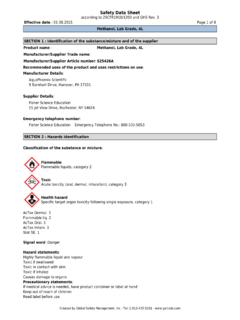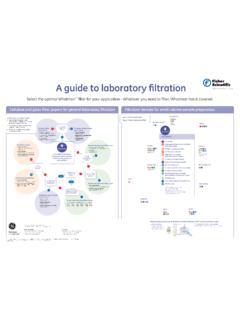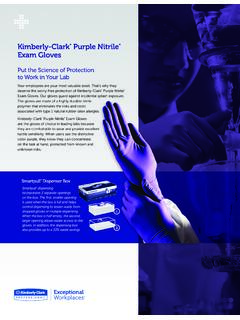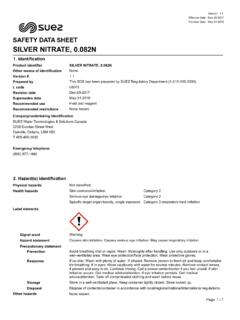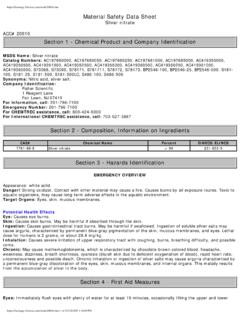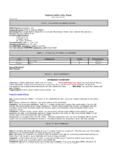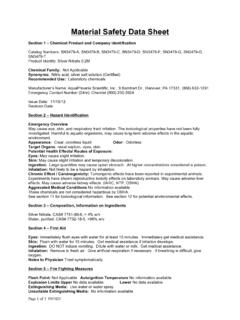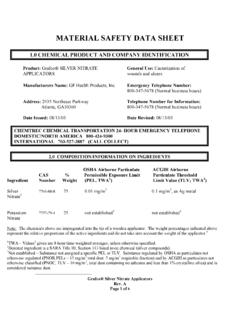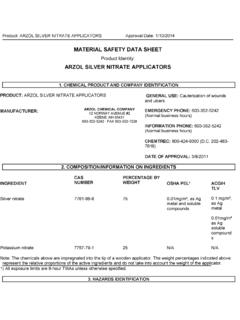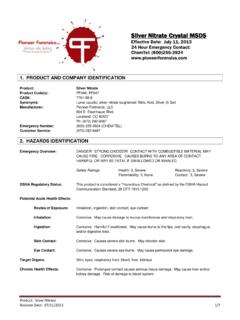Transcription of Safety Data Sheet - Fisher Scientific
1 Safety data Sheetaccording to 29 CFR1910/1200 and GHS Rev. 3 Effective date : 1 of 7 silver nitrate , by Global Safety Management, Inc. -Tel: 1-813-435-5161 - 1 : Identification of the substance/mixture and of the supplierProduct name : silver nitrate , Trade name:Manufacturer/Supplier Article number:S25526 Recommended uses of the product and uses restrictions on use:Manufacturer Details:AquaPhoenix Scientific9 Barnhart Drive, Hanover, PA 17331 Supplier Details: Fisher Science Education15 Jet View Drive, Rochester, NY 14624 Emergency telephone number: Fisher Science Education Emergency Telephone No.: 800-535-5053 SECTION 2 : Hazards identificationClassification of the substance or mixture:CorrosiveSerious eye damage, category 1 Skin corrosion, category 1 BEnvironmentally DamagingChronic hazards to the aquatic environment, category 2 Acute hazards to the aquatic environment, category 2 Eye Dam.
2 1 Aquatic Acute 2 Aquatic Chronic 2 Skin Corrosion 1 BSignal word :DangerHazard statements:Causes skin irritationCauses severe skin burns and eye damageToxic to aquatic life with long lasting effectsPrecautionary statements:If medical advice is needed, have product container or label at handKeep out of reach of childrenRead label before useWear protective gloves/protective clothing/eye protection/face protectionWash skin thoroughly after handlingAvoid release to the environmentDo not breathe dust/fume/gas/mist/vapours/sprayIF IN EYES: Rinse cautiously with water for several minutes. Remove contact lenses if present and easy to rinsingWash contaminated clothing before reuseSafety data Sheetaccording to 29 CFR1910/1200 and GHS Rev. 3 Effective date : 2 of 7 silver nitrate , by Global Safety Management, Inc.
3 -Tel: 1-813-435-5161 - INHALED: Remove victim to fresh air and keep at rest in a position comfortable for breathingImmediately call a POISON CENTER or doctor/physicianIF ON SKIN: Wash with soap and waterSpecific treatment (see supplemental first aid instructions on this label)Collect spillageIF SWALLOWED: Rinse mouth. Do NOT induce vomitingIF ON SKIN (or hair): Remove/Take off immediately all contaminated clothing. Rinse skin with water/showerStore locked upDispose of contents and container to an approved waste disposal plantOther Non-GHS Classification:WHMISD2 BENFPA/HMISNFPA SCALE (0-4)HMIS RATINGS (0-4)SECTION 3 : Composition/information on ingredientsIngredients:CAS 7732-18-5 Deionized %CAS 7761-88-8 silver %Percentages are by weightSECTION 4 : First aid measuresDescription of first aid measuresAfter inhalation: Move exposed to fresh air.
4 Give artificial respiration if necessary. If breathing is difficult clothing and place exposed in a comfortable medical assistance if cough or othersymptoms skin contact: Wash hands and exposed skin with soap and plenty of water. Seek medical attention ifirritation persists or if concerned. Seek immediate medical eye contact: Protect unexposed exposed eye gently using water for 15-20 minutes. Removecontact lenses while immediate medical swallowing: Rinse mouth with not induce vomiting. Never give anything by mouth to anSafety data Sheetaccording to 29 CFR1910/1200 and GHS Rev. 3 Effective date : 3 of 7 silver nitrate , by Global Safety Management, Inc. -Tel: 1-813-435-5161 - medical attention if irritation, discomfort, or vomiting important symptoms and effects, both acute and of ;Absorption into the body leads to the formation ofmethemoglobin which in sufficient concentration causes cyanosis.
5 Onset may be delayed 2 to 4 hours or of any immediate medical attention and special treatment needed:If seeking medical attention provide SDS document to physician. Physician should treat 5 : Firefighting measuresExtinguishing mediaSuitable extinguishing agents: Use water, dry chemical, chemical foam, carbon dioxide, or Safety reasons unsuitable extinguishing agents:Special hazards arising from the substance or mixture:Thermal decomposition can lead to release of irritating gases and oxides (NOx), silver /silveroxidesAdvice for firefighters:Protective equipment: Wear protective eyeware, gloves, and clothing. Refer to Section information (precautions): Avoid inhaling gases, fumes, dust, mist, vapor, and aerosols. Avoidcontact with skin, eyes, and 6 : Accidental release measuresPersonal precautions, protective equipment and emergency procedures:Ensure adequate that air-handling systems are contact with skin, eyes precautions:Should not be released into from reaching drains, sewer, or and material for containment and cleaning up:Wear protective eyeware, gloves, and clothing.
6 Refer to Section obey local necessaryuse trained response staff or contractor. Evacuate personnel to safe areas. Containerize for disposal. Refer toSection in suitable closed containers for spill with inert material ( vermiculite, sandor earth).Reference to other sections:SECTION 7 : Handling and storagePrecautions for safe handling:Avoid contact with skin, eyes, and good hygiene procedures when handling chemical to Section proper disposal methods. Refer to Section not eat, drink, smoke, or usepersonal products when handling chemical for safe storage, including any incompatibilities:Store in a cool away from food and from freezing and physical for containers. Keep container tightly sealed. Store away from incompatible materials. Protect storage temperature: 2 - 8 CSECTION 8 : Exposure controls/personal protectionSafety data Sheetaccording to 29 CFR1910/1200 and GHS Rev.
7 3 Effective date : 4 of 7 silver nitrate , by Global Safety Management, Inc. -Tel: 1-813-435-5161 - Parameters:7761-88-8, silver nitrate , ACGIH TLV TWA mg/m37761-88-8, silver nitrate , OSHA REL TWA mg/m3 Appropriate Engineering controls:Emergency eye wash fountains and Safety showers should be available inthe immediate vicinity of use or handling. Provide exhaust ventilation orother engineering controls to keep the airborne concentrations of vaporand mists below the applicable workplace exposure limits (OccupationalExposure Limits-OELs) indicated protection:Not required under normal conditions of use. Where risk assessmentshows air-purifying respirators are appropriate use a full-face particlerespirator type N100 (US) or type P3 (EN 143) respirator cartridges as abackup to engineering necessary use NIOSH approvedbreathing of skin:Select glove material impermeable and resistant to the material based on rates of diffusion and degradation.
8 Dispose ofcontaminated gloves after use in accordance with applicable laws andgood laboratory proper glove removal technique withouttouching outer surface. Avoid skin contact with used protection:Wear equipment for eye protection tested and approved underappropriate government standards such as NIOSH (US) or EN166(EU). Safety glasses or goggles are appropriate eye hygienic measures:Perform routine hands before breaks andimmediately after handling the contact with skin, eyes, rewearing wash contaminated 9 : Physical and chemical propertiesAppearance (physicalstate,color):Clear, Colorless LiquidExplosion limit lower:Explosion limit upper:Not DeterminedNot DeterminedOdor:OdorlessVapor pressure:14mmHg @ 20 COdor threshold:Not DeterminedVapor :Not DeterminedRelative density:Approx. 1 Melting/Freezing point:Approx 0 CSolubilities:Soluble in waterBoiling point/Boilingrange:Approx.
9 100 CPartition coefficient (n-octanol/water):Not DeterminedFlash point (closedcup):Not DeterminedAuto/Self-ignitiontemperature: Not DeterminedEvaporation rate:>1 Decompositiontemperature:Not DeterminedFlammability(solid,gaseous):No t DeterminedViscosity:a. Kinematic:nb. Dynamic: Not DeterminedDensity: Not DeterminedSafety data Sheetaccording to 29 CFR1910/1200 and GHS Rev. 3 Effective date : 5 of 7 silver nitrate , by Global Safety Management, Inc. -Tel: 1-813-435-5161 - 10 : Stability and reactivityReactivity:Nonreactive under normal stability:Stable under normal hazardous reactions:None under normal to avoid:Incompatible materials:Ammonium Hydroxide, organic materials, sulfides, charcoal, acetylene, ethanol,reducing agents, calcium carbide, alkalis, antimony salts, carbonates, bromides, arsenites, chlorides, ferrous salts,thiocyanates, Iodides, tartrates, tannic acid and decomposition products:SECTION 11 : Toxicological informationAcute Toxicity:Oral:LD50 Rat: 1173 mg/kg( silver nitrate )Chronic Toxicity: No additional Irritation: No additional :No additional Target Organ (STOT):No additional Measures:No additional :There are no known carcinogenic chemicalsin this product:Mutagenicity:No additional Toxicity:No additional 12.
10 Ecological informationEcotoxicity Persistence and degradability:Bioaccumulative potential:Mobility in soil:Other adverse effects: Toxicity of silver to aquatic life depends on hardness: the higher the concentration ofhardness, the higher the concentration of silver needed to be considered toxic. Has high chronic toxicity to aquaticlife which can cause shorten life span, reproductive problems, lower fertility, and changes in appearances andbehaviorSECTION 13 : Disposal considerationsWaste disposal recommendations:Contact a licensed professional waste disposal service to dispose of this of empty containersas unused or containers must not be disposed together with household garbage. It is theresponsibility of the waste generator to properly characterize all waste materials according to applicableregulatory entities (US ).

